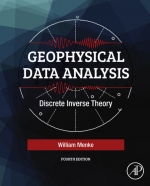Добрый день, Коллеги. Важное сообщение, просьба принять участие. Музей Ферсмана ищет помощь для реставрационных работ в помещении. Подробности по ссылке
Geophysical data analysis. Discrete inverse theory / Анализ геофизических данных. Дискретная обратная теория
Every researcher in the applied sciences who has analyzed data has practiced inverse theory. Inverse theory is simply the set of methods used to extract useful inferences about the world from physical measurements. The fitting of a straight line to data involves a simple application of inverse theory. Tomography, popularized by the physician’s CT and MRI scanners, uses it on a more sophisticated level.
The study of inverse theory, however, is more than the cataloging of methods of data analysis. It is an attempt to organize these techniques, to bring out their underlying similarities and pin down their differences, and to deal with the fundamental question of the limits of information that can be gleaned from any given data set.
Physical properties fall into two general classes: those that can be described by discrete parameters (e.g., the mass of the earth or the position of the atoms in a protein molecule) and those that must be described by continuous functions (e.g., temperature over the face of the earth or electric field intensity in a capacitor). Inverse theory employs different mathematical techniques for these two classes of parameters: the theory of matrix equations for discrete parameters and the theory of integral equations for continuous functions. <...>




